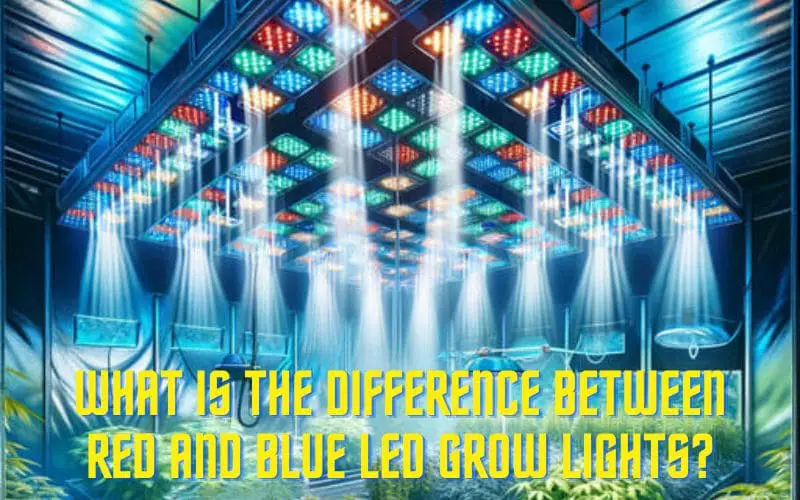What Is The Difference Between Red and Blue LED Grow Lights?

Introduction
Welcome to our comprehensive exploration of LED grow lights and their impact on plant growth and development. In this article, we will delve into the key differences between red and blue LED grow lights, their specific benefits, and the best applications for these lighting technologies in indoor gardening and commercial greenhouses.
Answer to the Question
The fundamental divergence between red and blue LED grow lights lies in their respective light spectra and the distinct effects they have on plant processes such as photosynthesis and growth regulation. Understanding these disparities is crucial for optimizing plant growth in various agricultural settings.
Benefits of Red LED Grow Lights
Energy Efficiency
Red LED grow lights are renowned for their exceptional energy efficiency, making them a cost-effective and sustainable lighting solution for plant cultivation. These lights are meticulously designed to emit specific wavelengths within the red spectrum, optimizing the photosynthetic efficiency of plants and minimizing energy wastage.
- Red LED grow lights consume significantly less energy compared to traditional lighting methods, resulting in lower electricity costs for indoor plant cultivation.
- By providing targeted light within the optimal wavelengths for plant growth, red LED lights reduce energy waste commonly associated with broad-spectrum lighting.
- The energy efficiency of red LED grow lights contributes to environmental sustainability by reducing overall energy consumption and carbon emissions.
Plant Growth and Photosynthesis
The utilization of red LED grow lights promotes robust plant growth and enhances the photosynthesis process. The specific red light spectrum stimulates flowering and fruiting in plants, making it an invaluable component in indoor gardening and greenhouse cultivation.
Benefits of Blue LED Grow Lights
Plant Growth Regulation
Blue LED grow lights play a pivotal role in regulating plant growth, particularly in controlling plant height and leaf development. These lights emit a distinct blue spectrum that influences plant morphology and overall growth patterns, contributing to optimal plant structure.
Optimal Light Spectrum
When it comes to providing the optimal light spectrum for plant growth, LED grow lights play a crucial role. The blue light spectrum, in particular, is essential for maintaining the ideal light conditions necessary for the healthy development of plants. Let’s delve deeper into the significance of the blue light spectrum and its effects on plant growth:
- Photosynthesis: Blue light, with a wavelength of approximately 400-500 nanometers, is an integral part of the photosynthetic process. It activates chlorophyll, triggering the conversion of light energy into chemical energy, which is essential for plant growth.
- Stem and Leaf Development: Blue light influences the development of sturdy stems and healthy leaves. It promotes compact, bushy growth by helping to regulate plant hormones and controlling stem elongation.
- Flowering and Fruit Production: In addition to its role in vegetative growth, blue light also plays a part in the transition to the reproductive stage. It affects the formation of flowers and fruits, contributing to overall yield and quality.
- Photomorphogenesis: The blue light spectrum is involved in photomorphogenesis, which refers to the physical and biochemical changes in plants in response to light. It influences processes such as seed germination, root development, and chloroplast movement.
The blue light spectrum complements the red spectrum, creating a balanced lighting environment that supports robust and vibrant plant development. By providing the necessary light wavelengths and intensities, LED grow lights with optimized blue spectrum contribute to improved efficiency and better plant growth outcomes.
Best Applications for Red and Blue LED Grow Lights
Indoor Gardening
Indoor gardening is a rewarding and practical hobby that allows individuals to cultivate a wide variety of plants within the comfort of their own homes. Red and blue LED grow lights play a fundamental role in the success of indoor gardening, providing the essential light spectrum for photosynthesis and enabling plants to thrive throughout their entire life cycles.
- Energy Efficiency: Red and blue LED grow lights are highly energy-efficient, consuming minimal electricity while delivering optimal light output for plant growth.
- Optimal Light Spectra: These grow lights are specifically designed to emit the most beneficial light spectra for plants, promoting robust growth, flowering, and fruiting.
- Versatile Applications: With red and blue LED grow lights, indoor gardeners can cultivate a diverse range of plants, including herbs, vegetables, flowers, and even fruit-bearing species.
By strategically placing red and blue LED grow lights, indoor gardeners can provide consistent and targeted lighting to their plants, resulting in healthier foliage, more vibrant blooms, and increased yields. These grow lights effectively mimic natural sunlight, allowing plants to photosynthesize efficiently regardless of the indoor environment.
Commercial Greenhouses
In commercial greenhouse settings, the strategic use of red and blue LED grow lights maximizes plant productivity and quality. These lights facilitate controlled growing conditions, enabling growers to cultivate high-quality produce consistently throughout the year.
- Enhanced Growth and Productivity: Red and blue LED grow lights are carefully calibrated to provide the ideal light spectrum for photosynthesis, promoting enhanced growth rates and increased productivity of greenhouse crops.
- Optimal Plant Development: The precise control of light spectrum and intensity from red and blue LED lights ensures optimal plant development, leading to healthier and more robust crops.
- Year-Round Cultivation: With the use of red and blue LED grow lights, commercial greenhouse operators can maintain consistent growing conditions regardless of the external environment, allowing for year-round cultivation of high-quality produce.
- Energy Efficiency and Cost Savings: LED grow lights are energy-efficient, leading to reduced operating costs for commercial greenhouse operations while also contributing to environmental sustainability.
Conclusion
In conclusion, the contrasting benefits and applications of red and blue LED grow lights underscore their significant impact on plant growth and development. By harnessing the tailored light spectra of these LED technologies, growers can optimize plant cultivation across diverse agricultural settings, paving the way for sustainable and efficient horticultural practices.
